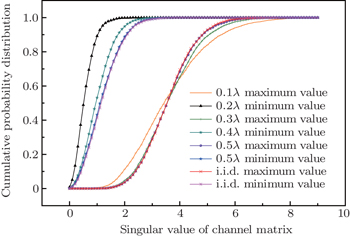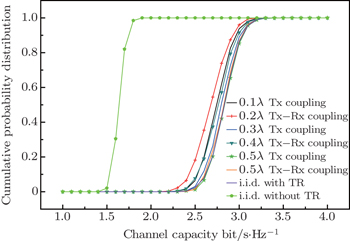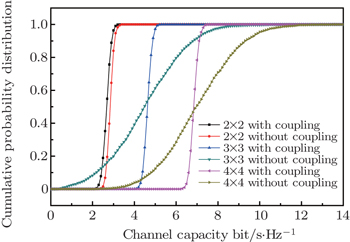† Corresponding author. E-mail:
Project supported by the National Natural Science Foundation of China (Grant Nos. 61331007, 61361166008, and 61401065) and the Specialized Research Fund for the Doctoral Program of Higher Education of China (Grant No. 20120185130001).
Utilizing channel reciprocity, time reversal (TR) technique increases the signal-to-noise ratio (SNR) at the receiver with very low transmitter complexity in complex multipath environment. Present research works about TR multiple-input multiple-output (MIMO) communication all focus on the system implementation and network building. The aim of this work is to analyze the influence of antenna coupling on the capacity of wideband TR MIMO system, which is a realistic question in designing a practical communication system. It turns out that antenna coupling stabilizes the capacity in a small variation range with statistical wideband channel response. Meanwhile, antenna coupling only causes a slight detriment to the channel capacity in a wideband TR MIMO system. Comparatively, uncorrelated stochastic channels without coupling exhibit a wider range of random capacity distribution which greatly depends on the statistical channel. The conclusions drawn from information difference entropy theory provide a guideline for designing better high-performance wideband TR MIMO communication systems.
Information theory provides a constructive criterion for building probability distributions based on partial knowledge, and prospers a kind of statistical subject which is called the maximum-entropy estimation.[1] Information entropy proposed by Shannon to measure the uncertainty has become a universal concept of statistical physics.[2] Information capacity is shown to be equal to the supremum over all processes of the input–output information rate. It is defined as the limiting information rate (in units of information per unit time) that can be achieved with arbitrarily small error probability.[3]
Multiple-input multiple-output (MIMO) technology has been used for increasing the channel capacity and information transmission rate, and has been widely investigated in cooperative communication,[4] wireless sensor networks,[5,6] terahertz communication systems,[7] fuzzy systems,[8] etc.
The application of time reversal (TR) was demonstrated first in acoustics detection, and then it was introduced into electromagnetics[9] and now it has been widely adopted in subwavelength focusing, super-resolution imaging,[10–12] and MIMO wireless communication.[13] With inherent spatial–temporal focusing property, TR can compress channel delay spread and alleviate inter-symbol interference which promotes itself as an ideal candidate in wideband or ultra-wideband communication.[14,15] Moreover, TR is a perfect paradigm for green wireless communication by exploiting the multi-path propagation from the surrounding environment.[16] Referring to the channels in the TR MIMO system, they often default for statistical uncorrelation. However, in realistic circumstances, the statistical correlation of channels caused by antenna mutual coupling will probably exist.[17]
Antenna mutual coupling will change the antenna radiation patterns and electrical current distribution. Two contradictory conclusions have been drawn from these research works about mutual coupling. One conclusion is that the induced radiation pattern caused by mutual coupling with reduced antenna separation may induce angle diversity: this may provide a new dimension for MIMO communication with improved power collection capability.[18] Another contradictory conclusion is that the channel correlation which is excited by mutual coupling will worsen the ill condition of the channel matrix. In this manner, antenna mutual coupling will become detrimental to systematic information capacity.[19]
In wideband TR MIMO system, the TR technique is to pre-code the information symbols with the conjugated and transposed channel information before transmission. The symbols can be viewed as experiencing an equivalent stochastic channel whose response is the convolution of the original propagating channel and its conjugate transposition.[20] Thus, traditional channel capacity of MIMO system is correlated with the eigenvalue of the MIMO channel matrix,[21] while the information capacity of TR MIMO system relates to the square of the eigenvalue of the channel matrix. Thus the different relationships with eigenvalues of the propagating channel matrix in MIMO system invoke our research with or without using TR. To our knowledge, it is the first time that the channel statistical correlation caused by antenna mutual coupling in wideband TR MIMO system has been investigated.
In this paper, we first derive the whole symbol transmission process in wideband TR MIMO system. Then the mutual impedances are calculated for dipoles with different distances. The wideband channels are divided into frequency flat sub-channels, and the corresponding correlation coefficient is calculated in each sub-channel based on the self- and mutual impedances of dipoles. Channel capacities are derived based on the correlation coefficients in each sub-channel combined with the statistically independent wideband Rayleigh channel.[22] It can be concluded that mutual coupling reduces the channel capacity slightly, but it makes the channel capacity steady in a small range, while the channel capacity with the wideband Rayleigh channel is distributed in a larger range which presents greater randomness and depends on the channel condition. This work provides a method of designing relatively optimal wideband TR MIMO system according to specific channels in realistic communications.
The rest of this paper is organized as follows. In Section 2 the wideband TR MIMO system and its computation method of information capacity are presented. In Section 3, the self- and mutual impedance matrix of dipole antennas are calculated by the CST Microwave Studio, then correlation coefficient matrix and channel matrix are calculated accordingly in each sub-channel, subsequently the channel capacity of the entire wideband TR system are computed. In Section 4 the results are analyzed. In Section 5 some conclusions are drawn from the present investigation.
Throughout this paper, we use the following notations: bold uppercase (lowercase) letters indicate the matrices (row or column vector); (·)T, (·)*, (·)H, and (·)−1 denote the matrix transpose, conjugate without transpose, conjugate transpose, and inverse matrix respectively.
The TR has gained plenteous attention in wireless communications. Apart from coping with the large delay spread of wideband or ultra-wideband channel thus mitigating inter-symbol interference,[23] it can also achieve better performance with lower transmitted power and increase the channel capacity tremendously.
In this paper, wideband multipath channel and the sampled channel model can be expressed as


In the MIMO system, assuming there are Mt transmitting antennas and Mr receiving antennas, then we can use Mr × Mt dimension matrix
At the k-th moment, (Mr × 1)–dimensional receiving signal vector









From the MIMO data link expressions, we can see that each data flow is the total channel effect of the corresponding receiver antenna to all the transmitter antennas. Then each signal flow on the corresponding antenna can be detected by a decision threshold, thus omitting the complex channel equalization process.[15]
Channel capacity is defined as the maximum of mutual information under all possible input distributions. The capacity in TR MIMO system is defined as[20]



According to circuit theory, the correlation coefficient matrix


Although the Kronecker channel model has many deficiencies, it is still applicable to the situation where antenna number is small and the signal-to-noise ratio (SNR) is low. Hence, the number of dipoles and the SNR are both small in all of our capacity simulations. In this regard, the Kronecker model fits our research very well.[25,26] In the Kronecker model, the correlation channel can be expressed by the separated correlation properties of both link ends

Substituting Eq. (

Applying singular value decomposition to each sub-channel matrix, 

In this section, all the simulation results are presented about how antenna mutual coupling affects the information capacity of TR MIMO wideband system. First we consider a 2 × 2 MIMO system. The simulations are implemented by using the following parameter values: all antennas are parallel dipole antennas, the working frequency band of dipole is 2.8–3.15 GHz, the central frequency is 3 GHz, and λ is the central wavelength. All the impedance values are calculated by the CST Microwave Studio.
Figure
In Fig.
 | Fig. 2. Variations of correlation coefficient with frequency of two dipoles for different normalized distances. |
Figure
The cumulative probability distributions of channel capacity with a 2 × 2 MIMO system in several different cases are shown in Fig.
The most apparent conclusion is that adopting TR in a 2 × 2 MIMO system can gain much larger capacity than in situations without TR. This is because the channel capacity of a TR MIMO system is correlated with the biquadrate of the channel singular values whereas the MIMO system without TR is just related to the square of singular values.[19,20] When the singular values are larger than one, they contribute to the capacity increase of a TR MIMO system. Another phenomenon is that although coupling will reduce the channel capacity of TR system, its effect is very limited due to a similar reason.
The cumulative capacity distributions of the 2 × 2 parallel dipoles with different normalized distances both at the transmitting and receiving terminals are shown in Fig.
 | Fig. 5. Variations of cumulative probability distribution with channel capacity in a 2 × 2 MIMO system with different normalized distances. |
How the capacities of the 2 × 2 parallel dipoles with different normalized distances both at the transmitting and receiving terminals change with SNR is demonstrated in Fig.
In Fig.
In this paper, the influence of antenna mutual coupling on the capacity in a wideband time reversal MIMO system combined with stochastic channels is investigated for the first time. By dividing the wideband frequency selective stochastic channel into frequency flat sub-channels, the statistical correlation coefficient matrixes related to the mutual impedance matrixes caused by antenna coupling are calculated accordingly in each sub-channel. The singular value cumulative distributions of channel matrix in different situations are compared, so are the information capacities in different MIMO communication settings. Conclusions can be summarized below. For one thing, by taking time reversal technology in a wideband MIMO system, the information capacity can be enlarged dramatically compared to the case without time reversal; for another thing, in a time reversal wideband MIMO system, channel statistic correlation caused by antenna mutual coupling stabilizes the information capacity distribution into a smaller range, which means that the mutual coupling weakens the randomness in the capacity of the channel, whereas the channel capacity with statistically independent channels is much more dependent on the channel.
| 1 | |
| 2 | |
| 3 | |
| 4 | |
| 5 | |
| 6 | |
| 7 | |
| 8 | |
| 9 | |
| 10 | |
| 11 | |
| 12 | |
| 13 | |
| 14 | |
| 15 | |
| 16 | |
| 17 | |
| 18 | |
| 19 | |
| 20 | |
| 21 | |
| 22 | |
| 23 | |
| 24 | |
| 25 | |
| 26 | |
| 27 |







